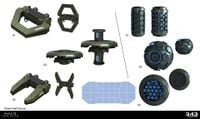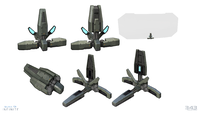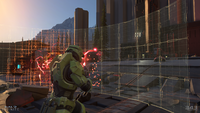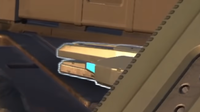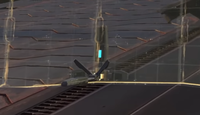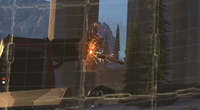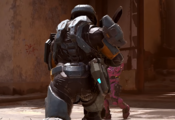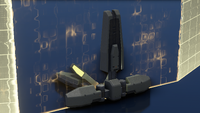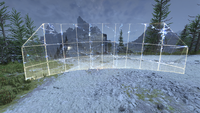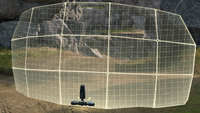Drop wall
From Halopedia, the Halo wiki
| Drop wall | |
|---|---|
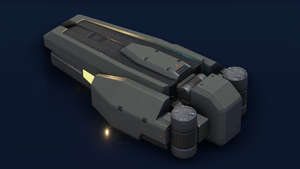
| |
| Production overview | |
|
Manufacturer: |
|
|
Type: |
|
| Service history | |
|
In service: |
|
- "A drop wall module. Deployable cover. Resilient but temporary."
- — The Weapon describing the drop wall to John-117.[1]
The drop wall is a piece of of UNSC infantry equipment compatible with the MJOLNIR (GEN3) armor.[1][3][4]
Overview[edit]
Design details[edit]
The drop wall has a compact and elongated design with slightly tapered ends. There are three panels and two smaller shield projectors that unfold during deployment.[5] Users typically carry the module on their hip.[3]
Operation[edit]
The drop wall operates similarly to the deployable cover and drop shield. When deployed, the drop wall projects a large energy shield that protects its user from enemy fire in combat, while still permitting the user to shoot through it.[3] After being deployed, the module unfolds, with two side panels and a top panel extending outward; two smaller projectors unfold at an angle diagonal to the three panels. When all three panels have fully opened to a right angle from the device's main body, the two small projectors generate a grid-like energy field. Each tile function as its own section, able to withstand limited damage before dissipating.
Operational history[edit]
While searching the Conservatory on Installation 07, John-117 retrieved a drop wall module from the body of Spartan Vedrana Makovich.[1]
In-game information[edit]
Halo Infinite[edit]
| “ | A single-sided deployable shield providing instant cover from enemy fire.[6] | ” |
The drop wall is a usable piece of equipment in Halo Infinite. It can be deployed in combat to provide the player with a temporary shelter from enemy gunfire, and is capable of stopping both gunfire and grenades. Additionally, the player is still able to shoot through the deployed drop wall, at their enemies. However, it degrades easily under damage, so the respite it provides is temporary.[2] Each section of the energy shield can only withstand a certain amount of damage from the outside before that section fails. Multiple sections can fail without the entire drop wall shutting down.[7]
Upgrades[edit]
In campaign, the drop wall is acquired from the body of Spartan Makovich in the level Conservatory; then it can be upgraded by collecting and spending Spartan cores. In multiplayer, the fully-upgraded drop wall can be selected as "Drop Wall (Campaign)" under Sandbox settings. In Forge, the fully-upgraded drop wall can spawn at an equipment pad by enabling the Legendary variant option.
| Name | Spartan core cost | Description |
|---|---|---|
| Swift Shelter | 1 SC | Reduces Drop Wall cooldown by 20%. |
| Rampart | 2 SC | Increases Drop Wall strength by 35%. |
| Blockade | 3 SC | Increases Drop Wall strength by 70% and increases wall size. |
| Direct Current | 3 SC | Adds shock damage to any projectiles fired through the Drop Wall. |
Production notes[edit]
The standard drop wall underwent a redesign between the Halo Infinite Campaign Gameplay Premiere in July 2020 and the A New Generation trailer in June 2021. The shape of the energy shield was changed from a simple curved wall to be more concave with less sharp outer angles.[2][7] In campaign, acquisition of the "Blockade" upgrade restores the curved shape to the drop wall module, though the corner tiles on the upper layer are triangular instead of rectangular.
Gallery[edit]

|
Browse more images in this article's gallery page. |
Concept art[edit]
Development images[edit]
John-117 behind an active drop wall in the E3 2021 showcase.
A Jovokada Workshop spike grenade stuck to a drop wall in the E3 2021 showcase.
Screenshots[edit]
HUD icon for the drop wall in Halo Infinite.
The drop wall module on a Spartan-IV's hip.
List of appearances[edit]
- Halo Infinite (First appearance)
- Halo: From the Soil to the Stars
Sources[edit]
- ^ Jump up to: a b c d Halo Infinite, campaign mission Connections: Conservatory
- ^ Jump up to: a b c Halo Infinite marketing, Campaign Gameplay Premiere
- ^ Jump up to: a b c Halo Infinite, gameplay
- ^ Halo Support, Halo Infinite Weapon, Equipment, and Vehicle Inventory (Retrieved on May 5, 2023) [archive]
- ^ Halo Infinite, Drop Wall in-game model
- ^ Halo Infinite, Campaign - Upgrades menu
- ^ Jump up to: a b Halo Infinite marketing, A New Generation
| ||


